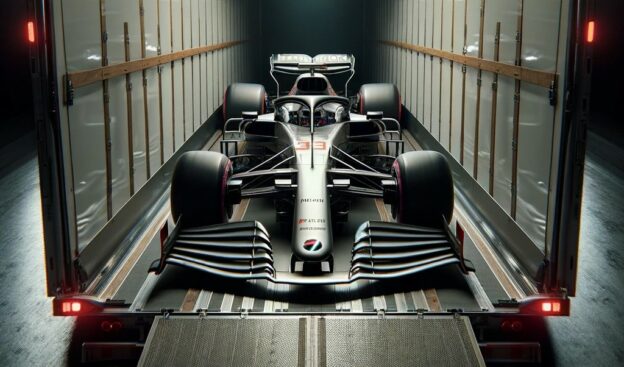Shipping an F1 Car

Many collectors have retired F1 cars, or buy the latest iterations from builders that sell them for private use. Regardless of how you come about your prized piece of engineering, you’ll need to ship it.
Shipping a Formula 1 (F1) car can be a complex process that requires meticulous planning and attention to detail. These sensitive vehicles need the right type of transport so it arrives at the track or your garage safely and in race-ready condition.
Here’s a detailed guide on how to ship an F1 car. We go over two specific options. The first one is doing it yourself. The next, is finding an experienced racing car shipper that specializes in race vehicles. We go through both in detail.
Do It Yourself - Finding a Suitable Race Car Trailer for an F1 Car
Some of the most die hard racers trust no one with their F1 car and also might want to enjoy the thrill of pulling up on race day to the track with everyone wondering what’s inside your trailer.. We understand that, so here we provide a way to do it on your own.
You can conveniently move your F1 car by using an enclosed transport trailer and tow vehicle. Enclosed shipping is the most secure way for moving a high-value and sensitive racing machine, so our guide will be focused on finding a single car enclosed trailer you can move on your own.
So the first step? Find a proper trailer to transport your F1 car safely and conveniently.
Trailer Requirements
The trailer you pick has to meet certain requirements. A suitable enclosed trailer provides a smooth and safe ride for your racer.
Size and Dimensions
F1 cars have specific dimensions; a suitable trailer must accommodate the car's length, width, and height comfortably, without risking damage. Typically, the internal dimensions should allow for easy loading and unloading of the car.
An F1 car is normally 80 inches wide by 37.5 inches tall and 220 inches long. Length can vary depending on the manufacturer, however most are about that wide, tall, and long.. Measure yours to be sure.
Weight Capacity
Ensure the trailer can handle the weight of an F1 car, which can be up to 746 kg (1,645 lbs) without fuel. This should be the easiest requirement, as most vehicles aren’t as lightweight as an F1 race car.
Climate Control
Considering the sensitive nature of F1 car components, opt for a climate -controlled trailer to protect against temperature fluctuations and humidity.
Secure Anchorage Points and Soft Ties
The trailer must have robust anchoring systems to secure the car firmly during transit, preventing any movement that could lead to damage. The ties should be soft, especially if being held to the frame. However, we recommend anchoring around the tires to prevent bending very light and thin components.
Finding and Choosing a Trailer
Start by researching companies that specialize in race car trailers. Look for manufacturers or dealers with experience in motorsports logistics.
Customization Options
Some companies offer customizable trailers that can be tailored to specific needs, such as additional storage for spare parts and tools.
New vs. Used
Decide whether to buy a new trailer or a used one. New trailers come with the latest features and warranties, while used trailers can be cost -effective but require thorough inspection.
Renting vs. Buying
If the transportation is a one-off or infrequent event, renting a trailer might be more economical. Check for rental agencies that offer enclosed race car trailers with the necessary specifications.
For teams or individuals that participate in multiple races throughout the season, purchasing a trailer might be a better investment. This option also allows for custom modifications to fit the team's exact requirements.
Using an Enclosed Auto Transport Company
Using a professional and experienced auto transport company allows you to focus on preparing for race day and is sometimes a better alternative than nervously pulling your trailer.
Look for transport companies that specialize in enclosed auto transport and have experience with high-value vehicles such as F1 cars.
Reputation
Check the company’s reputation within the industry. Look for reviews and feedback from other racing teams. See how they respond to bad reviews, if any. Check to see examples of cars like these being shipped.
Licensing
Make sure that whomever you choose, the company holds all necessary licenses for operating a transport service. This includes checking if they are registered with the Department of Transportation (DOT) and have a valid DOT and/or MC Number.
Insurance
Also, verify that the company offers adequate insurance that covers any potential damages during transit. The lower end price for a take-home F1 is easily $250,000 while real race ready cars are between 12 and 20 Million Dollars.
Comparing Car Transport Services and Prices
Get multiple quotes. Contact several reputable companies for quotes. Be specific about the services you need, such as door-to-door transport, climate control, and the route specifics.
Evaluate the Cost vs. Service
Choose a company that offers the best balance of cost, service, and security. Avoid selecting based solely on price as this might compromise the safety and security of the transport. Ask qualifying questions about how they handle the very low clearance and sensitive equipment that makes up your F1 race car.
Booking and Prep
Schedule in Advance! Book the transport well in advance of the race event to ensure availability and adequate preparation time. Follow the transporter's guidelines for preparing the car for shipment. This usually involves draining fluids, battery disconnect, and securing loose items like helmets and steering wheels..
Final Thoughts
Showing up in your own trailer and having fans watch you pull in is a great way to make an entrance at the track. However, trailering a valuable racing machine isn’t for the faint of heart. That’s why along with providing a guide to doing it yourself, you can also hire a qualified auto shipper to do the job.
✅ Check out more posts with related topics:













LAST 3 F1 Fan COMMENTS